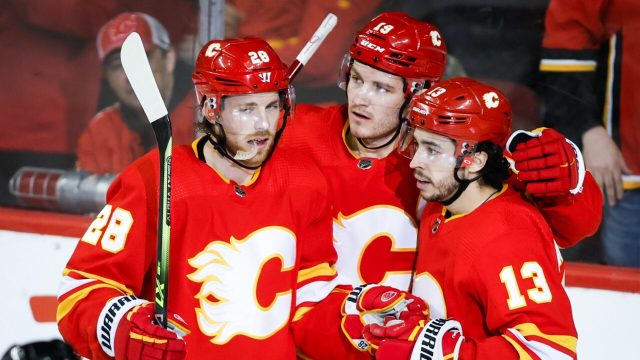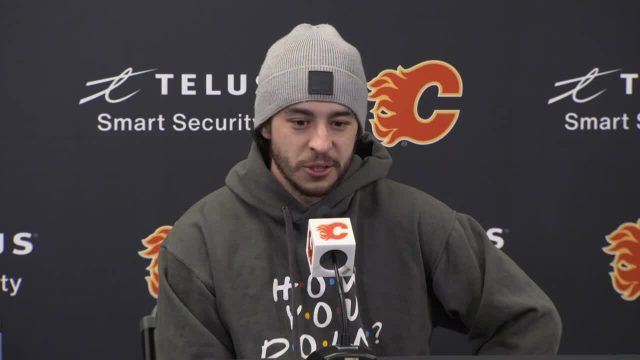Rewind the clock one year and the conversation around Johnny Gaudreau and the Calgary Flames was much, much different.
On April 14, 2021, the Flames were fifth in the North Division, six points back of Montreal and with three more games played. There was a clear divide in the division and Calgary was on the wrong side of it. They had been one of Canada's best teams in the latter half of 2019-20 before the pause, so this was a hugely disappointing development within a Canada-only division. Darryl Sutter was hired in March to try and save it — and though things did get better, the Flames just felt off.
Knowing that big contract decisions were upcoming in the summer of 2022, that finish opened the door to debate on where the Flames should go from here. Matthew Tkachuk, once thought to be the future captain when Mark Giordano left, was not seen as such an automatic choice for that role anymore. Giordano was claimed in the expansion draft by Seattle.
One of the bigger lingering issues was what should happen with Gaudreau. The mid-round draft find in 2011 has been a franchise cornerstone. He's been a top-three scorer on the team in each of his eight seasons, and the top scorer on five occasions (this season will be his sixth). But with his contract expiring in 2022, he wasn't necessarily an automatic re-sign.
For one, Gaudreau's post-season production has left something to be desired, with 19 points in 30 career playoff games. Aside from that, his 2018-19 season seemed to be the peak, when he posted a then-career high 99 points. In the two seasons that followed, Gaudreau posted 58 points in 70 games and 49 in 56. Good seasons to be sure, but a clear drop off from where he had been before.
Tkachuk was also up for a new contract in 2022, an RFA due a $9 million qualifying offer and one year away from UFA status. Then Andrew Mangiapane emerged and he also is an RFA, one year from UFA status, in 2022. So ... there was debate if the Flames should have traded Gaudreau at last year's trade deadline to get out ahead of it, or if it should have happened in the summer. It seemed like something of an inevitable move.
In 2021-22, though, it's fascinating how the whole situation has been turned on its head.
Today, the Flames are neck-and-neck with the Maple Leafs as Canada's best regular-season team and are second in the Western Conference. Gaudreau is having a new career-best season: with 101 points in 73 games he's fourth in league scoring. By the end of the season, he could finish with the second-best offensive campaign in Flames history.
So is he an automatic re-sign now?
It's complicated.

WHAT IS JOHNNY GAUDREAU WORTH ON HIS NEXT CONTRACT?
First we have to consider that Gaudreau is a left winger, a position that tends to be a tier lower than centre on the max earning-power scale. So we have to view how the market has shaped up within that context.
Gaudreau currently makes $6.75 million against the salary cap on a contract he signed in 2016. At that time, his deal accounted for 9.25 per cent of the salary cap. If you take that same percentage today on an $82.5 million cap (next year's projected upper limit) it comes out to about $7.6 million. That's probably the low-end of what we could look for on a Gaudreau extension.
He's already the 16th-highest paid left winger in the league and after the season he's been having he's sure to rise up that list. How high? Consider these comparables at the top of the position:
Artemi Panarin, New York Rangers
Cap hit: $11.642 million signed in 2019
Term: Seven years
Cap percentage at time of signing: 14.29
Status at time of signing: UFA
Jamie Benn, Dallas Stars
Cap hit: $9.5 million signed in 2016
Term: Eight years
Cap percentage at time of signing: 13.01
Status at time of signing: Pending UFA
Alex Ovechkin, Washington Capitals
Cap hit: $9.5 million signed in 2021
Term: Five years
Cap percentage at time of signing: 11.66
Status at time of signing: Pending UFA
Kirill Kaprizov, Minnesota Wild
Cap hit: $9 million signed in 2021
Term: Five years
Cap percentage at time of signing: 11.04
Status at time of signing: RFA
Benn appears to be the outlier here, but it's worth remembering he had won the Art Ross in 2015 (with 87 points). Besides that, this does appear to be a tier of players above Gaudreau, even after his 100-plus point campaign. Although, we always need to keep in mind that if he were to hit the open market in July, all bets are off, and that variable could be a factor in negotiations. Jeff Skinner got $9 million with plenty of term when he hit the market in 2019.
The tier below this group in terms of AAV is interesting because it includes a lot of RFA re-signings. Brady Tkachuk ($8.33 million), Andrei Svechnikov ($7.75 million), Patrik Laine ($7.5 million) and Kyle Connor ($7.142 million) all fall here. But, given their RFA status and how the teams still held control, they aren't direct comparables to Gaudreau's situation.
The next three players, who all make $7 million against the cap, are interesting to compare. Gabriel Landeskog, the captain of the Colorado Avalanche, got his payday and max term just last summer, right before he hit the open market. That's 8.59 per cent of this year's cap. Anders Lee got his 8.59 per cent share in 2019 and Max Pacioretty got his pay day after being acquired by Vegas in 2018 (his share was 8.81 per cent of a slightly lower cap).
Perhaps Gaudreau would have fit neater into this group if either he didn't have such a standout contract season, or if the cap wasn't on the rise again, with a big jump expected in three years. But even though some of you out there might be screaming about how you'd rather have one or two of these guys instead of Gaudreau, it is hard to see how he settles for $7 million (and a smaller share of the cap pie than his previous deal) before testing the open market.
When Taylor Hall — a past Hart Trophy winner — became a UFA in 2020, right in the middle of the pandemic and flat cap situation, he signed a one-year deal with Buffalo worth $8 million (9.82 per cent of the cap). And, honestly, that feels like the best place to start for Gaudreau. It's probably more comparable than the $6 million AAV and four-year deal Hall signed with the Bruins just last off-season. He wasn't coming off a kind of year Gaudreau is having, and he found a place that he wanted to be after bouncing around a little.
The only thing that might keep Gaudreau below $8 million is if he just wants to be in Calgary and is OK to settle for a bit less than his maximum earning potential.
“If (GM Brad Treliving) and the owners are happy with the way I’ve played here in the past six to seven years and it’s something we can figure out," Gaudreau said at the end of last season. "I would love to do that. I love the city of Calgary. I love playing here. I don’t think I’ve ever once said I haven’t wanted to be here.”
If Gaudreau were to get, say, $8.5 million on an extension, it would make him the sixth-highest paid left winger in the NHL by AAV and that 10.3 cap percentage would also be sixth at the position at the time of signing. While the RFAs just below him have future higher earning potential, this would be Gaudreau's biggest payday of his career.
And that number, $8.5 million, feels about right. We just wonder how much his playoff performance this spring could sway that number, or Calgary's willingness to invest it in him.

WHAT DOES CALGARY'S CAP PICTURE LOOK LIKE?
We mentioned earlier that Gaudreau isn't the only important piece of business the Flames need to resolve this summer. Tkachuk, also on pace for 100 points, needs a big-money, multi-year extension — if he goes to arbitration instead and takes a one-year deal, he'd be walking right into UFA status in 2023. That's probably not where the Flames want to go with him. Mangiapane has slowed lately (just two goals in his past 20 games) but he did have a breakout campaign and has scored 31 times
Oliver Kylington, another RFA, has had a breakout season of his own and will get a notable raise on his $750,000 as well.
Calgary's other pending UFAs include: Calle Jarnkrok, Ryan Carpenter, Brett Ritchie, Trevor Lewis, Nikita Zadorov, Erik Gudbranson, and Michael Stone. Highly unlikely they're all back.
The picture is this: Calgary will go into the off-season with roughly $26 million in projected cap space, per Cap Friendly. That's with 10 skaters and two goalies already under contract.
Let's pencil in Gaudreau at $8.5 million, but keep it in our minds that he could reach $9 million. Tkachuk will get at least $9 million on the qualifying offer, and possibly more if he extends multiple years. For right wingers, Mitch Marner is the highest-paid at $10.93 million and Patrick Kane next at $10.5 million. Mark Stone and Nikita Kucherov are third at $9.5 million. Given the history of Tkachuk family negotiations, it's hard not to imagine Matthew coming out of this as at least tied with Stone and Kucherov on a multi-year extension. He might even get to $10 million.
For Mangiapane, market comparables indicate he could roughly double his current $2.425 million AAV and, it should be noted, his agent Ritch Winter told Eric Francis that his advice to the player will be to take a short-term deal, or possibly settle in arbitration that would walk him to free agency.
If we project Gaudreau at $8.5 million, Tkachuk at $9.5 million and Mangiapane at $5 million that totals $23 million, leaving Calgary with $3 million of cap space and still needing to sign at least three forwards and one defenceman. And that doesn't include an extra body or two.
So, ya, things will get tight.
SO WILL THE FLAMES HAVE TO CHOOSE BETWEEN GAUDREAU OR TKACHUK?
Not necessarily. There is one possible option that would give the team more room to fill out the depths of the roster and keep the band together.
Buy out Gaudreau's good buddy and long-time former linemate Sean Monahan.
Making $6.375 million against the cap, Monahan was moved down as far as the fourth line this season and lost his place on the power play after the trade deadline. He had just 23 points and managed just 28 a year ago. Injuries have slowed him down and necessary hip surgery ended his 2021-22 campaign a couple weeks ago.
It's just no longer financially viable for the Flames to roster him at that cost, considering the other investments they'll need to make. Assuming Monahan does return to health and won't be a permanent LTIR candidate (and eligible to be bought out), if the Flames did buy out the last two years of his contract, they would save an additional $4 million in cap space next season. In sum, that would mean roughly $7 million in remaining space. (While there will be an extra cost in 2023-24, that's also the year Milan Lucic comes off the books.)
https://news.google.com/__i/rss/rd/articles/CBMiaWh0dHBzOi8vd3d3LnNwb3J0c25ldC5jYS9uaGwvYXJ0aWNsZS9jYXAtY29tcGFyYWJsZXMtd2hhdC1jb3VsZC1qb2hubnktZ2F1ZHJlYXVzLW5leHQtY29udHJhY3QtbG9vay1saWtlL9IBaGh0dHBzOi8vd3d3LnNwb3J0c25ldC5jYS9uaGwvY2FwLWNvbXBhcmFibGVzLXdoYXQtY291bGQtam9obm55LWdhdWRyZWF1cy1uZXh0LWNvbnRyYWN0LWxvb2stbGlrZS9zbi1hbXAv?oc=5
2022-04-14 19:07:00Z
1372718631

Tidak ada komentar:
Posting Komentar